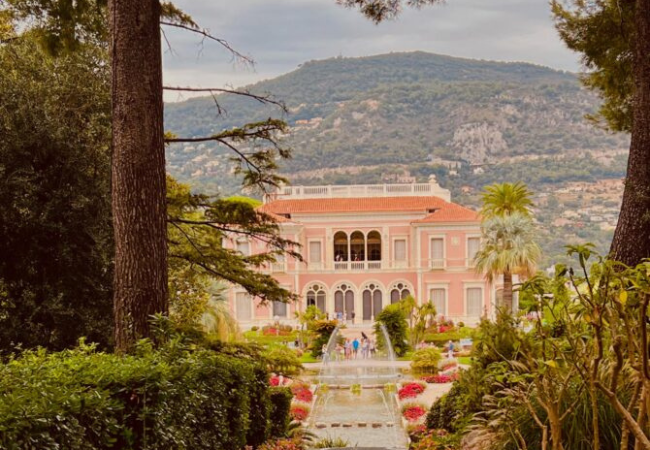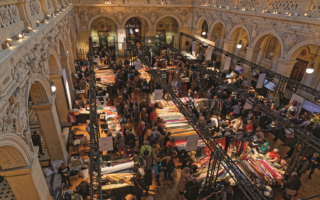The Riches of Beatrix de Rothschild
Looking down from the Medieval hilltop village of Eze, you can clearly make out the square, pink Villa Ephrussi de Rothschild at the very heart of the peninsular that is Saint-Jean-Cap-Ferrat. Once the private residence of the fabulously wealthy Baroness Ephrussi de Rothschild, it is now a museum run by the ‘Academie des Beaux-Arts’ and filled with every kind of beauty the Baroness brought together – a poetic evocation of the places and things she loved.
Born Charlotte Beatrix de Rothschild in 1864, she was the granddaughter of James de Rothschild, one of five brothers who founded the dynasty of bankers and were made Barons by the Emperor of Austria. Her mother, Leonora, was also a Rothschild born into the English branch of the family, and her father Alphonse ended his career as Governor of the Bank of France. Beatrix grew up in a luxurious 19th Century Chateau Ferrieres in Seine-et-Marne, with a family mansion in Rue Saint-Florentin in Paris. Beatrix’s father was a great collector and a great benefactor of French museums. She acquired his love of precious things – Louis XV furniture, Sevres porcelain, silks and satins, and fine art. When her father died, the inheritance she shared with her brother was estimated at 700 million euros.
GALLERY:Please add some images
At the age of 19, the newly named Beatrice married Baron Maurice Ephrussi, whose jewish family came from Odessa, then part of Russia. But the marriage was not a happy one, and Beatrice threw herself into a whirl of travel – transatlantic voyages and luxury trains. An ardent admirer of the ‘Belle Epoque’, she organized lavish parties with unashamed wealth in the pursuit of pleasure, and adopted the tastes of the ‘Enlightenment’ aristocracy, amassing a great collection of art works. She had been unlucky in love, but consoled herself with the beauty of masterpieces from France. Her hair went white at the age of 20, and she was known to be eccentric, always dressing in a pink gown. She always had an aviary in her homes and owned hundreds of birds, two monkeys and a pet mongoose that slept beside her bespoke Louis XVI-style chair.
The Baroness was constantly planning and overseeing new building projects and in 1905, she acquired prime land in Saint-Jean-Cap-Ferrat from King Leopold II of Belgium, who himself owned the neighbouring villa. She appointed local builder, Aaron Messiah, who had worked on many other villas on the Cote d’Azur, to begin the building of her own ‘Villa – Ile de France’. Beatrice was consumed by the project, spending the next seven years focussed on creating an ideal setting to exhibit her extensive collection of ‘objets d’art’. Her dream ‘gardens over the sea’, 4 hectares of Herculean landscaping on rock, first had to be dynamited before masses of earth was brought in to level it. Hundreds of Italian workers were hired for the digging and Beatrice insisted that the gardeners wore sailors’ berets so she felt as if she were living among the crew of a steamship sailing around the world! The Villa was built with thick glass panels along its terraces to protect the garden from the wind, like those protecting the decks of ocean liners. With the Mediterranean lying on both sides, Port and Starboard, it was the Baroness’s illusion of being at sea.
GALLERY:Please add some images
Then came the dark days of World War I which changed everything. Baron Ephrussi died in 1916 and Beatrice gave up her villa, not returning for twenty years. Finally, in 1933, aged 70 and childless, Baroness Ephrussi bequeathed it to the ‘Academie des Beaux-Arts’. At her death, all the priceless objects from her residences in Paris and Monaco were taken to the Villa Ephrussi, where her beloved gardens were sadly left unfinished.
It is a remarkable story of one woman’s incredible life of wealth, travel and passion for the arts. As I walk from room to room, the Villa has certainly retained the spirit of a Salon, preserving exquisite personal items that enhance an image of this slight, gentle-faced lady. ‘The Patio’, an indoor foyer, evokes Italian Renaissance villas with its Medieval colonnades and 15th and 16th Century architectural themes from Venice and Florence. The gallery running around at mid-height displays wrought iron features and works of art form an Italian/Spanish patchwork that stands in strong contrast to other rooms. I move into the ‘Grand Salon’ with its sumptuous painted panelling, and a carpet of bright pinks and blues with the monogram of Louis XV at its centre, brought here from the gallery of the Royal Chapel at Versailles. There are two sofas and eight armchairs all upholstered in 19th Century silk from Lyon, as well as column clocks. Two gaming tables, one with extremely refined scrolled legs and bead decoration, illustrate the real passion the Baroness had for gambling, when she frequented the Casino in Monte Carlo.
GALLERY:Please add some images
Moving through the Villa, I am amazed by the abundance of priceless treasures from Fragonard paintings, Chinoiseries, Wurzburg, Sevres and Vincennes porcelain, and an 18th Century door in black lacquer with gold from the Imperial Palace in Beijing. In one room, entirely devoted to an exquisite display of Sevres, I admire a set of three bright green lidded vases dating from 1780, each painted with family scenes evoking the three ages of life. This was typical of the Bourgeois-style of art in the decades before the French Revolution. The ‘Sevres Garden’ is reached directly from the Dining Room, across a terrace which overlooks the aviaries that were built in the arbours. White ibises used to walk freely in the space, protected by a net hung between the pergola and retaining wall.
From the upstairs rooms the views out over the gardens to the Mediterranean on either side are spectacular and truly fulfil the Baroness’s dream of ‘a living garden’. The pools at the ‘Temple of Love’ at the top of the garden date from the Villa’s inauguration in 1912. There are Koi carp in a pool with pebble sides in the Japanese Zen garden. I wander past prickly pear trees, and woodland enriched by creeping fig. The dazzling corals and crimsons of Azaleas and Fuchsias and bold white Hydrangeas mix with clusters of orange Aloe flowers, adding to the flamboyance.
From a gently winding footpath, where classical music emanates from Provencal plant beds, I come to admire the most famous French roses in memory of Beatrice Ephrussi de Rothschild, who had a passion for the pink colour of their blooms. Indeed, the large species ‘Baronne de Rothschild’ is a nod to Beatrice’s family background – their big, fragrant double blooms are an intense ‘Solferino’ pink.
No doubt Beatrice would approve.
GALLERY:Please add some images
Share to: Facebook Twitter LinkedIn Email




